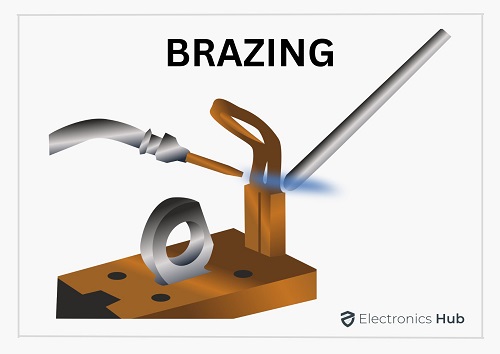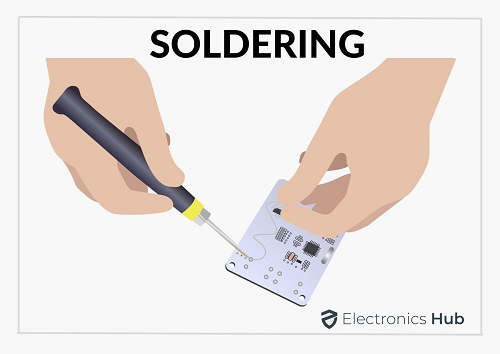In this article, you’ll find detailed info about soldering and brazing procedures. You’ll also find a brief comparison between these two processes. So, if you’re curious to know more, let’s begin.
About Brazing
Brazing is a procedure of joining two or more metals together. It doesn’t involve the melting of base metal. There’s a filler metal used, which is melted at over 450 degrees and flown through the two metals that need to be joined. Once the filler metal flows, it uses capillary action to join the metal pieces together.
Here are some characteristics of brazing:
Use of molten filler: As said earlier, brazing involves heating & melting of filler material. When it dries or becomes solid, it joins the metal pieces strongly. Filler alloy: The filler used is usually an alloy with a lower melting temperature than the base metals. Different Metal types: Using this process, you can join dissimilar metals like nickel, silver, gold, and even copper. Strength: If performed properly, brazing can make metals join tightly. However, the bond isn’t as strong as it is in welding.
Advantages and Disadvantages of Brazing
Advantages of Brazing
You need a lower temperature and power to use this process. You can use it to join dissimilar base metals. Better joint strength than soldering There’s not much stress applied to the base metal. It’s good for joining delicate metals.
Disadvantages of Brazing
The joint strength is lower than welding Sometimes the flux can contain toxic materials
About Soldering
Now soldering is a process similar to brazing. In soldering, you again use a filler metal to join the base material together. However, the temperature of the filler material never exceeds 450 degrees. It also works using the capillary action.
Welding vs Soldering Soldering iron vs Soldering gun What is the perfect soldering iron temperature? Soldering iron tip Soldering techniques & tips
The filler materials reach between two metals until the empty space is clogged. And during this process, the base materials don’t melt. Here again, the filler’s melting point should be lower than the metals you are joining.
Advantages and Disadvantages of Soldering
Advantages of Soldering
It has a lower power and temperature requirement as compared to brazing and welding You can join metal with thin walls You can join dissimilar metals No need for heat treatment after the process
Disadvantages of Soldering
You cannot use temperatures exceeding 450 degrees, which is a constraint Strength of joint is lower as compared to brazing and welding You cannot join large sections using this process
Soldering vs. Brazing–What’s the difference?
Let’s understand the difference between soldering and brazing with a comparison chart: –
Welding vs. Soldering: Comparison chart
Well, if you want to know the difference between soldering and welding, refer to the comparison chart below: –
Key Considerations to choose between brazing and welding
Brazing and welding procedures produce permanent and strong joints. However, if you want to choose one process for a specific purpose, what would it be? Well, to know about that, please refer to the below key considerations: –
1. Assembly Size
When it comes to joining large assemblies, welding is what you should go for. It’s because large assemblies tend to produce more heat. And this can make it hard to reach the flow point of the filler material. Welding produces intense heat, which makes it efficient in handling larger assemblies.
2. The thickness of the metal
If you’re joining metal pieces as thick as 12.7mm or more, it’s good to prefer welding. However, if the sections are thinner, brazing is excellent. It’s because the brazing process involves lower temperatures. And in such cases, there are fewer chances of the metal surface being pierced. But if you use welding for thin sections, the intense heat can tear through the surface. It’s the reason why welding is not preferred for thin sections.
3. Joint Configuration
You can produce joints with both brazing and welding. If you want to join two metals at a single point, welding can help. It’s because the heat is localized. The electric resistance produces a lot of heat within seconds and is economical too. However, if you have linear joints, it’s better to braze. It’s because welding heat will take a lot of time to travel from one end to the other. And this can happen instantly if you use brazing. It’s because the filler quickly travels to the unstable joints.
4. Aesthetics or Appearance
Some joining procedures such as plumbing faucets, glass frames, and jewelry appear superior. And if you have such an application in mind, brazing is an excellent choice. With brazing, you would notice a minor fillet. However, in the case of welding, you’ll see an irregularly shaped bead.
5. Material Type
Joining dissimilar metals can be challenging. But brazing makes it an easy job. Brazing can provide a strong joint without altering the base material’s properties. However, the filler used should be compatible with the metals you want to join. Also, the melting point of filler should be lower as compared to base materials. Now, it’s hard to join dissimilar metals using welding. It’s because, in welding, one has to melt the base metal. And if the melting points of two metals are close, the process can be too expensive. Brazing here comes with a solution. You can choose the compatible filler material. You can even join nonmetals like alumina, diamond, tungsten carbide, etc., using the brazing technique.
6. Volume of work
If there are fewer assemblies to be managed, one can get it done manually. Otherwise, machine welding is preferred. Usually, when it comes to choosing between brazing and welding, it depends on the material type, thickness, and size. And when It comes to the volume of work, cost and ease of use are considered.
Conclusion
Whether it’s brazing, soldering, or welding, every process has its ups and downs. However, you can make the right choice by considering the material type, appearance, assembly size, and joint strength. Such factors can help you determine which process is suited best for which purpose. So, go through the info and make the right choice. Comment * Name * Email * Website
Δ







![]()